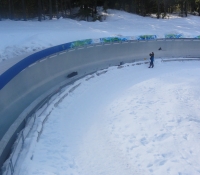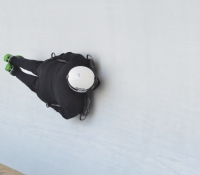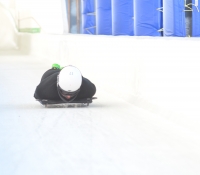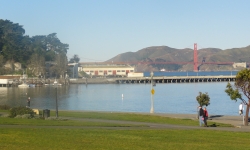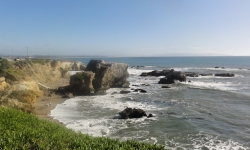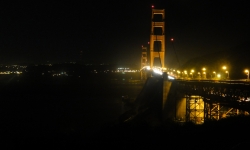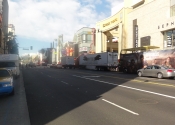A few weeks ago a colleague of mine mentioned that he tried out skeleton (the winter sliding sport, like Luge or Bobsleigh) which had become an Olympic event, from the 2010 Vancouver Winter Olympics. My friend was all excited about it. And knowing how I like to try new things, specially if they are right on the edge of… holding for your dear life, let’s say, he made sure I know about his experience. He described to me the whole experience, and I was sold. I tried to talk other colleagues into it; to go as a group. But, the slightly high price tag for the activity, and adding the fear factor has deterred them all. But I must try it I said.
So, today was the day. The Whistler sliding center is in Whistler, BC, where most of the 2010 Vancouver Winter events were held and that’s where the sliding tracks are. There are 17 sliding tracks in the world, four in North America. This sliding track here in Whistler is the fastest track in the world, were a record speed of 153.98km/h was reached on this track. Also, sadly, this is the same track where an olympic luger has lost his life during a training session during the 2010 Vancouver Winter Olympics. And yes, this is the same track I went on today.
So, the whole event takes about 2 hours, and you get 2 runs @ ~30 seconds each. We were a group of 23 people (excluding friends & families which can come along to watch and cheer). The first 30 minutes consists of having us signing wavers, and going through some slides describing the dos and don’ts, safety stuff, get a helmet fitted, how to mount the sled, how to position one’s body, shoulders, head, arms (someone will demo), etc… Basically, the point is as they say “just be like a sac of potatoes”. This activity is open for public because it’s safe. It’s quite the rush, but safe. You may get some bruises, or some abrasion on your elbows or even chin (which has happened to one of the guys today), as you may start bouncing between the walls! The bouncing (called “ping-pong”) may happen when non-trained people try to steer themselves away from walls, as a reaction of fear from hitting the walls. Or that some people get tense, which causes their shoulders to rise up (shoulders should be relaxed touching the sled, while lying down on your belly) which would offset the flow of the sled, and causes the sled to react to the person’s unintended body movements.
Once, the introductory stuff is out-of-the-way, we head to the starting point of the sliding track, were we get called one by one for our first run. At this point you get to see all sort of reactions from the people. Some had the look “Crap! what did i get myself into”. Others are excited, and some cocky! So, as the time passes waiting for your turn, people start to get more and more nervous. As you’d hear people bouncing off walls! Once a person finishes his or her first run, then they’d wait by the finish line, and watch the rest of the group members make their way down the track. I should add that for public we don’t actually run the complete track. We start from the 1/3 of the track, to slide only through the last two-thirds of the track. This is done so that we don’t pick too much a speed, since we don’t know what to do. Again, the point is to just lie down on the sled, relax (yeah right!) and let the track, gravity and physics do the rest.
So, here comes my turn, I put on the helmet, which has this chin guard (as it will rub against the ice!). The staff help me get into position (yeah, that joke was played on a lot today!) on my stomach on the sled, they explain to me to keep my legs straight and balanced just off the ice, to keep my shoulders pushed down into the sled, to keep my arms straight and close to my body, to NOT LET GO of the sled’s handles, to keep my chin up, and that if the chin guard starts rubbing against the ice, to move my chin a little forward, to fight off the g-forces (2-3 times one’s body mass acting down on the neck). Are you ready? Screw you Grant!
I start sliding, and all I can think of is keep legs straight, keep arms close to body, keep chin up! And then it hits you! I mean the speed just picks up very quickly! The problem is that you can’t see much in front of you. They tell us to keep our shoulders down, and to not lift the head as it will make the shoulders rise (this would also slow you down, if you are trying to get top speed). So by having your head down, all you can see is may be a foot ahead, and it’s one big icy blur. Suddenly, I started feeling my sled turning, and fighting forces acting on my body. The thing is you can’t tell what position your body/sled is in. As one goes trough the corners, the sled rises sideways on the icy wall. So the sled is going forward but sometimes we are sliding on the wall, which is perpendicular to the ground. I couldn’t tell if I’m going right, left or straight anymore! All I feel is that it’s getting faster and faster, and I’m trying to not screw things up! At some point the speed and forces peaked, I realized that I’m in the last and fastest corner. My chin guard starts to grind against the ice, so I push my chin forward and that solves it. The next thing I know I’m ping-ponging my way out of the last corner. I feel this pain in both my arms just above the elbows as I’m bouncing off the walls. I didn’t know how long that last corner was. I feared the worst, as it felt that the skin on my arms is getting scrapped as it’s rubbing against the ice walls (I was wearing clothes!). Then, I slowly come to a stop. I didn’t know whether I had finished or my run had come to a stop, due to me using my elbows as brake pads. It was the former, I had finished. The staff helped me get off my sled. I take a second to let my head process all of what I just went through. I start walking to the stands where everybody else was gathered.
I hear “that’s gotta hurt”. “It did!”, I reply. As when we finish our runs, we stand to the side, and watch the next person come out into the finish line. So, the people standing there had watched me “ping-pong” my way out of corner 16. I quickly look at my elbows, and there was no blood dripping! The injuries felt worst than they looked.
First of all, it’s not as scary as my colleague has made it to be. I’ve experienced bigger g-forces on some of the roller coaster @ Six Flags a few weeks ago. However, not knowing what’s going to happen in your first run ever, makes it very nerve-wracking to say the least! The whole time going down, I was so focused about keeping my body in the correct position, that the run seemed too short even if it lasted ~30 seconds. It felt more like 10 seconds! As my sled/body would turn I’d be worried about losing control, or sliding off the sled, or knocking my head or whatever. It’s this that keeps you on the very edge, and hoping for it to be over! So, when my first run was over, I was like, OK, it’s not as extreme as I thought it would be, but the fear of the unknown makes you expect the worst.
So, armed with some knowledge, bruises, and some blood, we all walk back to the starting line again; for our second and final run. This time I was feeling more relaxed. My first run was timed @ 29.75s for a top speed of 99.6km/h. Let me tell you, having your eyes a few inches from the icy track at that speed… is actually too fast for my brain to process!
As the people go through their second runs, we start hearing about some “difficulties” announced on the radio. I should add that at every run, they announce over the speakers (as they would in any sport event) your name. And after the run is complete, they would announce your track time and top speed. Anyways, as we wait for our turns, we start hearing stuff like, someone has some minor cut on their elbow, but nothing major. And I’m like been there, done that. At some point, they announced that someone has fallen off their sled, but managed to get back on! My confidence is starting to drop, and the fear of the known is starting to seep in! Then we hear that someone has done a 180 somwhere on the track, and is now sliding legs first!! Then we hear that he made another 180 and now is back to the normal position, head first. Now, I have no longer have any confidence left. Later on, the guy said he doesn’t know what happened. He was just spinning. I believe him! Things happen so fast, and we are not trained, so we have no control. And that’s actually a good thing. It’s when amateurs like us try to steer and control the sled that stuff goes wrong!
So, here am I, up for my second and final run of the day. This time, I make an effort to keep my arms straight, and close to my body. It’s when the arms get a little loose and make “little chicken wings” as they call them, that the elbows would stick out, and would hit the walls (as it happened in my first run), if the sled happens to hit and drag by the wall. So, here I go! Starting out slowly, keeping my arms straight, shoulders down into the sled, legs balanced just above the icy track, and chin forward enough to not have the chin guard rub against the ice. Speed picks up. I feel my body/sled going sideways, left, right, straight, and all over the place. But, I can’t tell how is my body/sled positioned relative to the track. Again, the speed picks up, I realize I’m in my last corner. I straighten my arms, and keep my elbows locked straight. My chin guard starts to grind against the ice. I push my chin forward, and that stops the grinding. It happens a couple more times. I anticipate the ping-pong again. This time it doesn’t happen. Progress!
My second run was much smoother than my first run. However, to my surprise it was slower than my first run. Run #1: 29.75s @ 99.6km/h. Run #2: 30.33 @ 96.6km/h. That’s still insane! ! Going ~100km/h where your chin is an inch or two off the track, and all you can see is a big fast white icy blur is insane! I would do it again!
While we were standing at the finish line, waiting for the rest of the group to complete their runs, I saw a man coming out to the finish line, with some blood on his chin. Turns out that as his chin guard (attached to the helmet) has slightly moved out place, when it hit the icy track in some corner, which then exposed his chin. So, in the following corner he hit his chin on the ice causing some abrasion to his chin. Nevertheless, this guy got top speed of the day @ 101.1km/h.
So, all in all, it’s awesome! It’s totally worth the price. For those who are into extreme sports, they must try this at least once. And for everyone else, don’t be intimidated by how scary it may or may not be, just go and try it. They wouldn’t open this sport for public if it was dangerous!
And here’s how the professionals do it, on the very same track.

